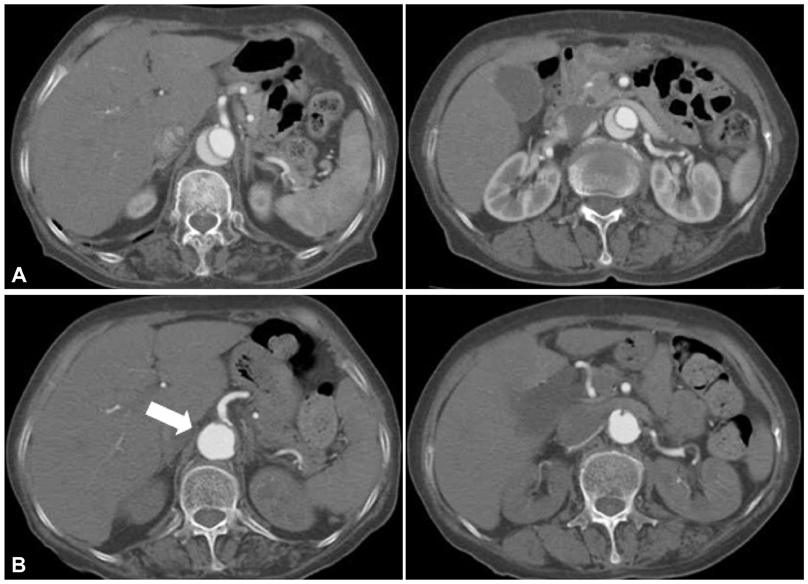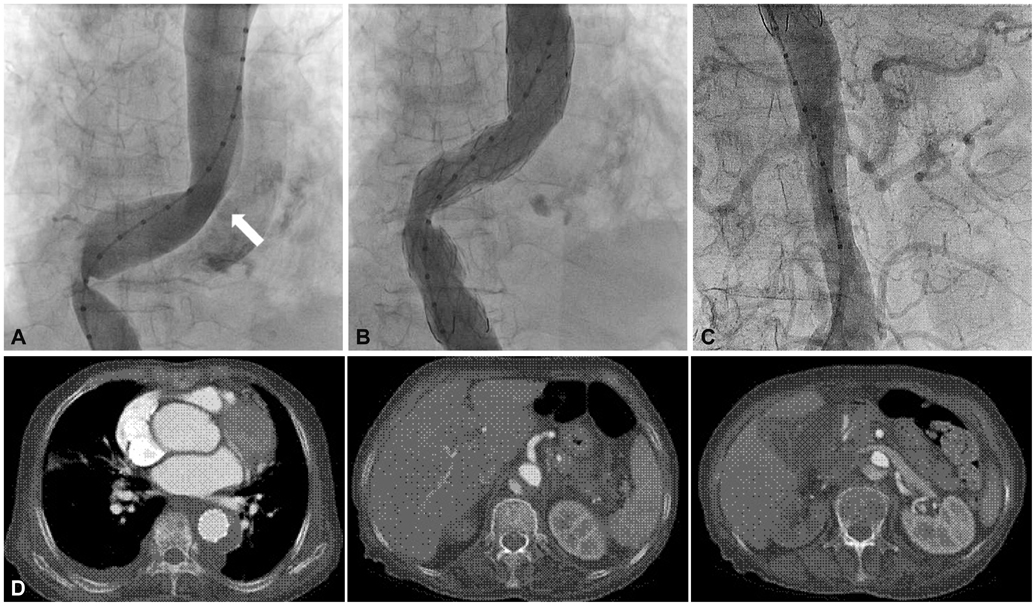Korean Circ J.
2012 Sep;42(9):638-640. 10.4070/kcj.2012.42.9.638.
Placement of Endovascular Stent Graft in Acute Malperfusion Syndrome After Acute Type II Aortic Dissection
- Affiliations
-
- 1Department of Thoracic and Cardiovascular Surgery, Kyungpook National University Hospital, Daegu, Korea. straightroot@knu.ac.kr
- KMID: 2297897
- DOI: http://doi.org/10.4070/kcj.2012.42.9.638
Abstract
- Acute malperfusion syndrome is a serious complication of acute aortic dissection. A 76-year-old female patient was admitted with acute type B aortic dissection and developed renal malperfusion during medical therapy. We are reporting a clinically successful result from the thoracic endovascular aortic repair used for malperfusion syndrome that occurred by acute type B aortic dissection.
Keyword
Figure
Reference
-
1. Tsai TT, Fattori R, Trimarchi S, et al. Long-term survival in patients presenting with type B acute aortic dissection: insights from the International Registry of Acute Aortic Dissection. Circulation. 2006. 114:2226–2231.2. Lauterbach SR, Cambria RP, Brewster DC, et al. Contemporary management of aortic branch compromise resulting from acute aortic dissection. J Vasc Surg. 2001. 33:1185–1192.3. Williams DM, Lee DY, Hamilton BH, et al. The dissected aorta: part III. anatomy and radiologic diagnosis of branch-vessel compromise. Radiology. 1997. 203:37–44.4. Williams DM, Lee DY, Hamilton BH, et al. The dissected aorta: percutaneous treatment of ischemic complications--principles and results. J Vasc Interv Radiol. 1997. 8:605–625.5. Panneton JM, Teh SH, Cherry KJ Jr, et al. Aortic fenestration for acute or chronic aortic dissection: an uncommon but effective procedure. J Vasc Surg. 2000. 32:711–721.6. Suzuki T, Mehta RH, Ince H, et al. Clinical profiles and outcomes of acute type B aortic dissection in the current era: lessons from the International Registry of Aortic Dissection (IRAD). Circulation. 2003. 108:Suppl 1. II312–II317.7. Chen S, Yei F, Zhou L, et al. Endovascular stent-grafts treatment in acute aortic dissection (type B): clinical outcomes during early, late, or chronic phases. Catheter Cardiovasc Interv. 2006. 68:319–325.
- Full Text Links
- Actions
-
Cited
- CITED
-
- Close
- Share
- Similar articles
-
- Complicated Acute Aortic Dissection with Malperfusion of the Left Common Iliac Artery Treated with Thoracic Endovascular Aortic Repair
- Thoracic Endovascular Repair for Complicated Type B Acute Aortic Dissection with Distal Malperfusion
- Retrograde Stanford type A aortic dissection after endovascular stent graft placement for type B dissection
- A Case of Complete Resolution of Aortic Dissection in the Descending Thoracic Aorta Treated with Endovascular Stent-Graft Implantation
- Mid-Term Results of Thoracic Endovascular Aortic Repair for Complicated Acute Type B Aortic Dissection at a Single Center



